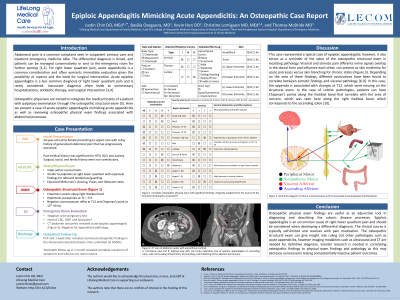Back

OPP/OMT, Biomechanics
Epiploic Appendigitis Mimicking Acute Appendicitis: An Osteopathic Case Report
Friday, March 31, 2023
12:00 PM East Coast USA Time


Justin Chin, DO (he/him/his)
Resident Physician
Lifelong Medical Care
Emeryville, California, United States
Presenting Author(s)
Introduction: Acute abdominal pain is a common complaint seen by primary care and emergency medicine physicians. Ranging from benign causes such as gastroenteritis and constipation to more life-threatening emergencies such as appendicitis and perforation, necessitating a wide differential and clinical suspicion in examination skills and testing. This case describes acute appendigitis and how it can mimic acute appendicitis and other more life threatening pathologies. The osteopathic structural exam can help localize symptoms and suggest possible diagnoses.
Case Study: Here we present the case of Ms. L, a 54 year old Latinx female who presented to the urgent care for 2 day of diffuse abdominal pain, localizing to the right lower quadrant. Physical exam showed rebound tenderness and guarding, with equivocal findings with provocative measures such as the McBurney’s point, psoas sign, and obturator test. She was sent to the emergency room due to concern for acute appendicitis, in which abdominal ultrasound was negative. Computerized tomography of the abdomen revealed epiploic appendigitis of the ascending colon and she was discharged on supportive care. Outpatient follow-up 2 days later revealed resolving symptoms and an osteopathic exam showing viscerosomatic reflexes in the distribution of the colon and Chapman’s points along the right iliotibial band.
Discussion: Acute epiploic appendigitis is a rare cause of abdominal pain, often misdiagnosed as acute appendicitis or diverticulitis given similar clinical presentation and findings. The treatment is supportive care and is typically self-limited. This is the first report in the literature that comments on osteopathic findings in epiploeic appendigitis. The osteopathic structural exam was suggestive of a non-appendiceal origin of her pain, in which emergent surgery could be avoided. Requiring computerized tomography to identify, acute epiploic appendigitis is a rare cause of abdominal pain and should be considered in the differential diagnosis. The osteopathic structural exam should be utilized to help localize viscerosomatic findings to acute pathologies. Future directions can include designing treatments for somatic dysfunction related with epiploic appendigitis.
Case Study: Here we present the case of Ms. L, a 54 year old Latinx female who presented to the urgent care for 2 day of diffuse abdominal pain, localizing to the right lower quadrant. Physical exam showed rebound tenderness and guarding, with equivocal findings with provocative measures such as the McBurney’s point, psoas sign, and obturator test. She was sent to the emergency room due to concern for acute appendicitis, in which abdominal ultrasound was negative. Computerized tomography of the abdomen revealed epiploic appendigitis of the ascending colon and she was discharged on supportive care. Outpatient follow-up 2 days later revealed resolving symptoms and an osteopathic exam showing viscerosomatic reflexes in the distribution of the colon and Chapman’s points along the right iliotibial band.
Discussion: Acute epiploic appendigitis is a rare cause of abdominal pain, often misdiagnosed as acute appendicitis or diverticulitis given similar clinical presentation and findings. The treatment is supportive care and is typically self-limited. This is the first report in the literature that comments on osteopathic findings in epiploeic appendigitis. The osteopathic structural exam was suggestive of a non-appendiceal origin of her pain, in which emergent surgery could be avoided. Requiring computerized tomography to identify, acute epiploic appendigitis is a rare cause of abdominal pain and should be considered in the differential diagnosis. The osteopathic structural exam should be utilized to help localize viscerosomatic findings to acute pathologies. Future directions can include designing treatments for somatic dysfunction related with epiploic appendigitis.
